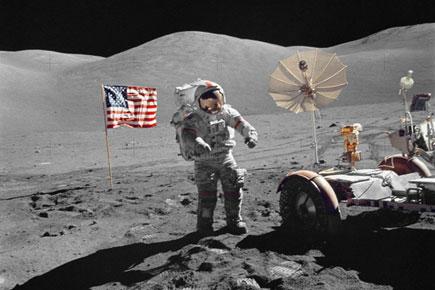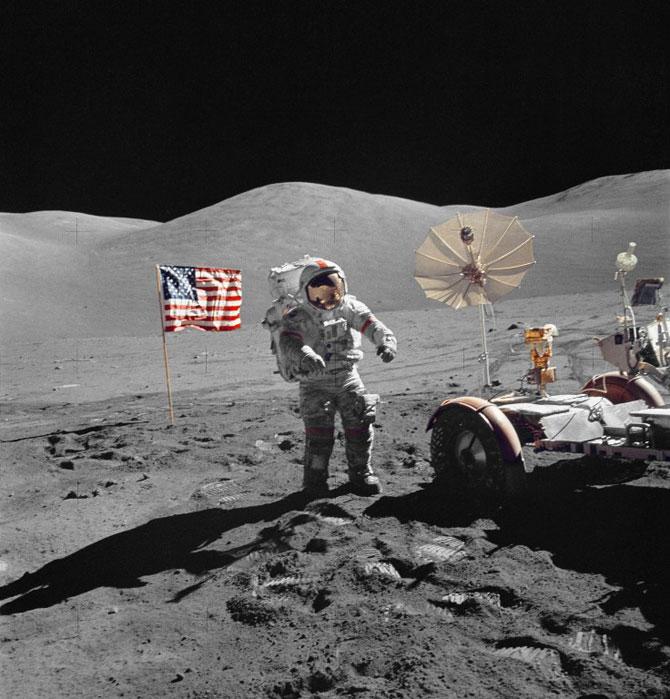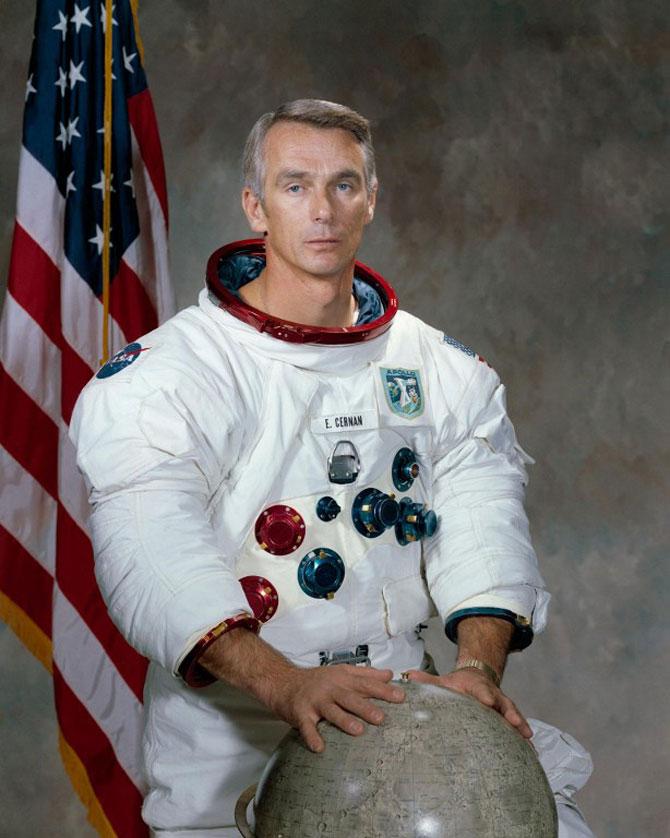Eugene A. Cernan, the commander of the Apollo 17 lunar-landing mission in 1972 and the last man to walk on the moon, died in Houston on January 17. Here are some facts about the retired US astronaut

 This December 13, 1972 image courtesy of NASA shows Astronaut Eugene A. Cernan, mission commander, walking toward the Lunar Roving Vehicle (LRV) during extravehicular activity (EVA) at the Taurus-Littrow landing site of NASA's sixth and final Apollo lunar landing mission. Pic/AFP
This December 13, 1972 image courtesy of NASA shows Astronaut Eugene A. Cernan, mission commander, walking toward the Lunar Roving Vehicle (LRV) during extravehicular activity (EVA) at the Taurus-Littrow landing site of NASA's sixth and final Apollo lunar landing mission. Pic/AFP
ADVERTISEMENT
Eugene A. Cernan, the commander of the Apollo 17 lunar-landing mission in 1972 and the last man to walk on the moon, died in Houston on January 17. Here are some facts about the retired US astronaut.
>> Cernan was born in Chicago, Illinois, on March 14, 1934. He was one of 14 astronauts selected by NASA in October 1963 for the Apollo programme, created to send humans to the moon.
>> Cernan also participated in Gemini missions, NASA's second human spaceflight programme, developed to support subsequent Apollo missions.
>> On his first space flight, Cernan became the second American to walk in space during the Gemini IX mission in 1966, led by command pilot Thomas Stafford.
 Gene Cernan
Gene Cernan
>> On his second sojourn in May 1969, he was pilot of Apollo 10's lunar module, the first comprehensive lunar-orbital qualification and verification flight test of an Apollo lunar module.
>> Cernan was the third person to walk in space, following Russian Alexei Leonov and American Ed White. Cernan spent two hours and seven minutes outside the Gemini 9 spacecraft on the 1966 mission but had to come in early because his helmet visor was fogging up due to exertion. Because the spacewalk was shortened, Cernan did not have a chance to test a new jetpack. He recalled the incident in his memoir in a chapter titled "The Spacewalk From Hell."
>> Cernan holds the moon's speed record, having driven the lunar rover at 11.2 miles per hour (18 km per hour) on a downhill run.
>>He almost missed out on Apollo 17 because he severely strained a tendon in his leg playing softball with NASA personnel two months before the launch. He used crutches for a week and willed himself not to limp so NASA officials would not pull him from the mission but said walking on the moon was painful.
>> Security at Cape Kennedy had to be increased for Apollo 17 because of the threat of attack from Black September, the Palestinian group that had killed 11 Israelis at the Summer Olympics in Munich three months earlier. Officials also were concerned about the astronauts' families, so authorities followed their children's school buses and federal agents kept an eye on their classrooms.
>> Less than two weeks after returning from the moon, Cernan and crew mate Ron Evans went to Bimini in the Bahamas for New Year's as the guests of the chief executive of Rockwell International. Cernan said the executive was an old friend but there were conflict of interest concerns in Washington because Rockwell manufactured modules for NASA spacecraft. Cernan was given a letter of reprimand from the agency.
>> The 1972 last mission to the moon established several firsts for manned spaceflight including: longest manned lunar landing flight (301 hours 51 minutes); longest lunar surface extravehicular activities (22 hours 6 minutes); largest lunar sample return (an estimated 115 kg (249 lbs.); and longest time in lunar orbit (147 hours 48 minutes).
>> Cernan retired from the Navy after 20 years in 1976 and ended his NASA career. He went into private business and served as television commentator for early fights of the space shuttle.
>> Cernan met Neil Armstrong, the first man to walk on the moon, at Purdue University, where they studied in the 1950s.
-with inputs from agencies
 Subscribe today by clicking the link and stay updated with the latest news!" Click here!
Subscribe today by clicking the link and stay updated with the latest news!" Click here!











